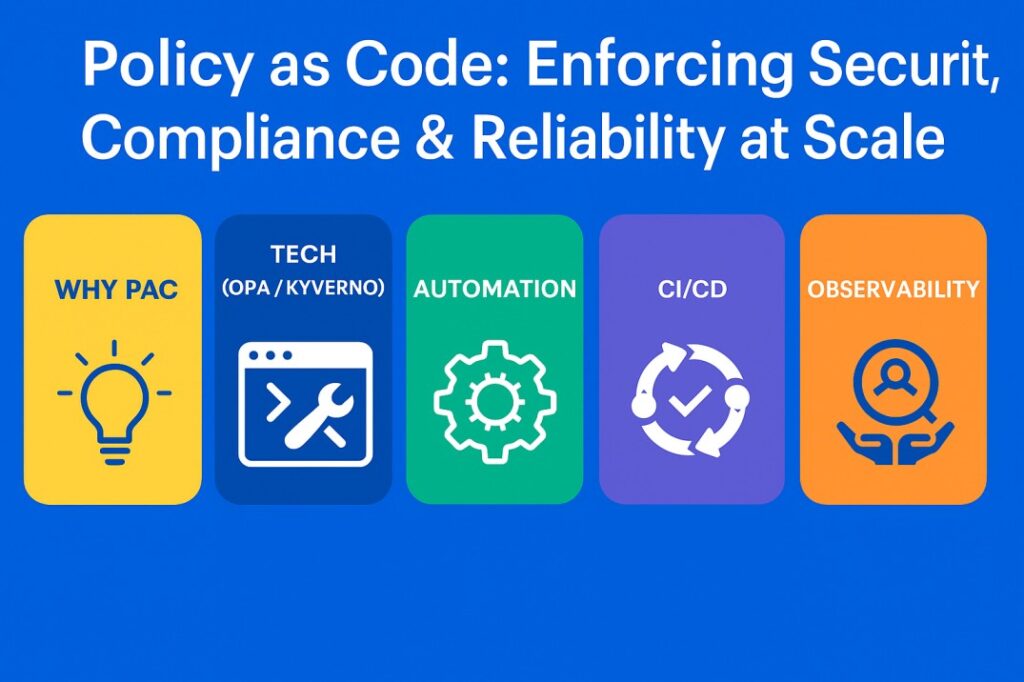
In 2025, cluster security isn’t enforced by humans – it’s enforced by code. As Kubernetes estates grow across clouds and teams, manual policies collapse under scale. Policy as Code (PaC) turns guardrails into automated, testable, version-controlled rules.
1. Why Policy as Code?
- Kubernetes is dynamic – thousands of manifests updated daily.
- Engineers push changes faster than platform teams can review.
- Compliance (PCI, SOC2, GDPR) requires provable controls, not tribal knowledge.
PaC ensures every deployment obeys security + reliability rules before reaching production.
2. The Tech Behind Policy as Code
PaC enforces rules on YAML, runtime behavior, and cluster state using:
✔ OPA Gatekeeper
- Validates manifests at admission.
- Rejects dangerous configs (privileged pods, hostPath, missing labels).
Example: Require labels
apiVersion: constraints.gatekeeper.sh/v1beta1kind: K8sRequiredLabelsspec: match: kinds: - apiGroups: [""] kinds: ["Pod"] parameters: labels: ["team", "env"]✔ Kyverno
- Easier to write, YAML-native.
- Mutate, validate, and generate policies.
Example: Prevent privileged pods
validate: pattern: spec: containers: - securityContext: privileged: "false"✔ Terraform + Sentinel / Open Policy Agent
- Infrastructure-level policy checks before provisioning.
3. Automating Compliance & Security
Policy as Code enforces:
- Security: Block root users, unsafe capabilities, open ingress rules.
- Reliability: Enforce liveness/readiness probes, resource limits.
- Governance: Require labels/annotations for cost allocation and ownership.
- Multi-cloud consistency: Same policies across AWS, GCP, Azure, on-prem.
PaC doesn’t just validate YAML – it validates intent.
4. CI/CD Integration
Policies run at:
- Pull request time → catch violations early.
- Admission controller time → enforce guardrails.
- Runtime audits → detect drift and outdated configs.
This adds shift-left + shift-right protection layers.
5. Observability for Policies
- Export Gatekeeper/Kyverno metrics to Prometheus.
- Alerts for: Policy violations Failed mutations Admission rejections Drift from declared policy
- KubeHA AI correlates policy failures with pod crashes, security alerts, and misconfigurations.
6. The Business Value
- Stronger security posture
- Reduced misconfigurations
- Automated audit readiness
- Consistent governance across teams and clusters
- Less manual review → faster developer velocity
Bottom Line
Policy as Code converts best practices into automated guardrails that protect clusters at scale. In 2025, it’s not optional – it’s the backbone of Kubernetes security, compliance, and reliability.
👉Follow KubeHA for ready-to-use Kyverno/OPA policies, CI/CD templates, and multi-cluster compliance automation.
Experience KubeHA today: www.KubeHA.com
KubeHA’s introduction, 👉 https://www.youtube.com/watch?v=PyzTQPLGaD0